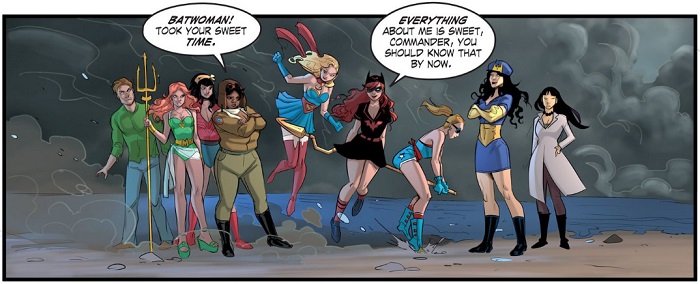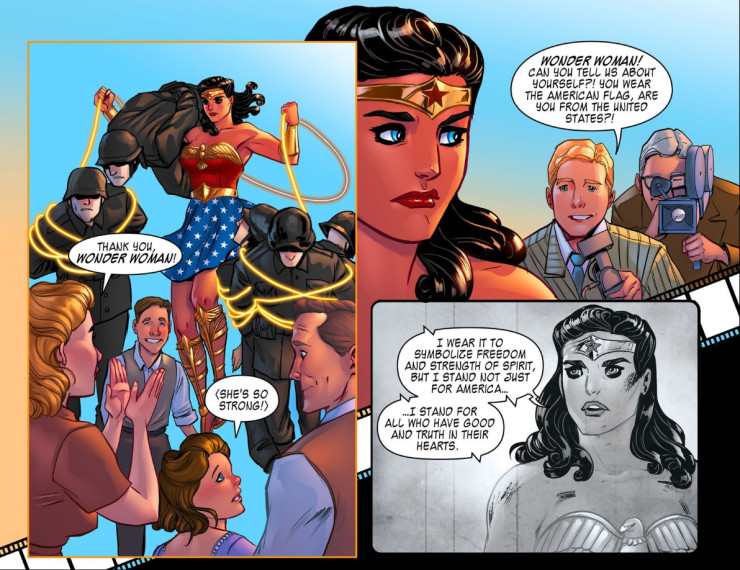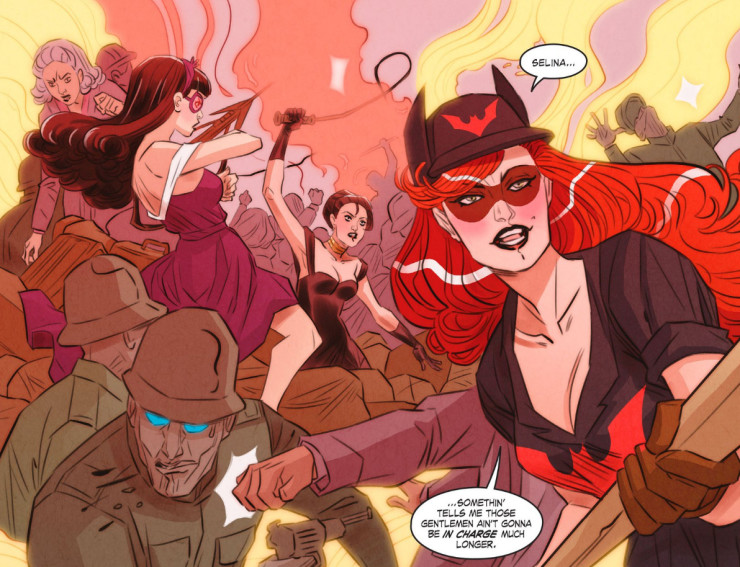With every passing day DC continues to double-down on its weird insistence on grimdark storytelling and tokenized diversity. Last month’s announcement of the unpleasant new “Rebirth” reboot has only grown less appealing with the reveal at WonderCon this past weekend of its creative teams. Only four women are on the creative side of the multiverse event, two of the female-led series are being run by dudes, and no women are running any male-led series (of which there are way more than necessary). And don’t even get me started on the melodramatic, erratic, illogical, OOC-ness of Batman v Superman.
Wait! Don’t leave yet! Not everything DC does is painful, I swear! Besides the joy that is their TV offerings (well, maybe not Gotham…), they publish two wonderful digital comics: DC Comics Bombshells and The Legend of Wonder Woman. These two non-canon series are delightful examples of what happens when DC stops grafting grimacing white men on everything and lets the creators tell their own excellent stories.
We’ll also have a quick chat about one of the best debut issues of the year so far: Black Widow by Mark Waid and Chris Samnee. It’ll blow your socks off, for reals.
Origin Stories
The Legend of Wonder Woman
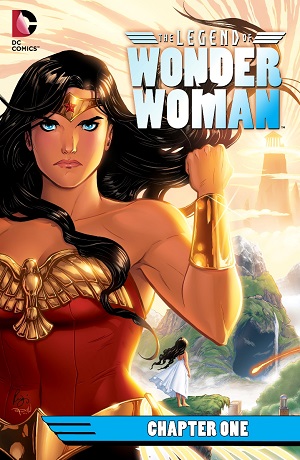 Capitalizing on the increased interest in Wonder Woman, The Legend of Wonder Woman reboots Diana’s origin story. The series starts on the Amazon-ruled island of Themyscira, but our heroine soon leaves for America as she searches for answers about the fate of her mother. A singer named Etta takes her in and the two eventually head to Europe to support the Allied troops waging war against the Nazis. The Duke of Deception sets his sights and zombie army on the Allied forces and only Diana is daring enough to take them on.
Capitalizing on the increased interest in Wonder Woman, The Legend of Wonder Woman reboots Diana’s origin story. The series starts on the Amazon-ruled island of Themyscira, but our heroine soon leaves for America as she searches for answers about the fate of her mother. A singer named Etta takes her in and the two eventually head to Europe to support the Allied troops waging war against the Nazis. The Duke of Deception sets his sights and zombie army on the Allied forces and only Diana is daring enough to take them on.
The Legend of Wonder Woman is a weekly digital-first series with three-issue mini-stories umbrella-ed under a larger arc. The series is helmed by writer and penciler Renae De Liz and inker/colorist Ray Dillon. Both De Liz and Dillon do the cover art. The first issue released November 2015, and #20 dropped March 24, 2016, with an issue being released every week. There is no print volume thus far, although print issues have made their way onto shelves. Digital series often have a long lag between online and print versions, so there are fewer analog options available than digital.
DC Comics Bombshells
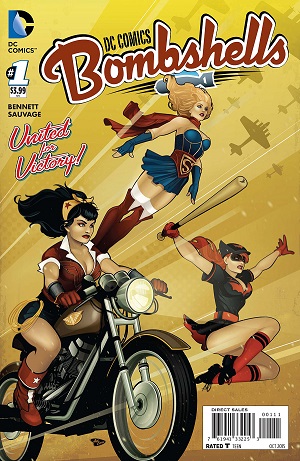 The DC Bombshells were first introduced as 1940s-style pinup statues and their popularity grew in leaps and bounds. In this ‘verse, Supergirl and Stargirl are Russian Night Witches, Batwoman is a baseball player with a gun for a bat, Zatanna and a bunny-fied John Constantine are double-agents in a Nazi cabaret run by the Joker’s Daughter, Amanda Waller is a military captain, and Catwoman is a seductive Italian contessa. Wonder Woman, Big Barda, Doctor Light (Kimiyo Hoshi), Harley Quinn, Poison Ivy, Mera, Alysia Yeoh, Huntress, and Baroness Paula von Gunther play major roles as well, with the Riddler, Steve Trevor, and others supporting. The story is an alt-history take on World War II where the Baroness leads an army of the undead, Chthonic monsters make a powerplay, and Nazis terrorize Europe, and it’s up to the Bombshells to defeat them all and save the world.
The DC Bombshells were first introduced as 1940s-style pinup statues and their popularity grew in leaps and bounds. In this ‘verse, Supergirl and Stargirl are Russian Night Witches, Batwoman is a baseball player with a gun for a bat, Zatanna and a bunny-fied John Constantine are double-agents in a Nazi cabaret run by the Joker’s Daughter, Amanda Waller is a military captain, and Catwoman is a seductive Italian contessa. Wonder Woman, Big Barda, Doctor Light (Kimiyo Hoshi), Harley Quinn, Poison Ivy, Mera, Alysia Yeoh, Huntress, and Baroness Paula von Gunther play major roles as well, with the Riddler, Steve Trevor, and others supporting. The story is an alt-history take on World War II where the Baroness leads an army of the undead, Chthonic monsters make a powerplay, and Nazis terrorize Europe, and it’s up to the Bombshells to defeat them all and save the world.
Bombshells debuted July 2015 as a digital-first series. Issue #36, which wrapped up the most recent story, released online on March 25, 2016, and a print volume compiling the first six issues is also on sale, as are some individual print issues. Each storyline spans three issues and are loosely connected under the main series arc. The series is written by Marguerite Bennett, while pencils/inks/colors alternate for each mini-arc and include Marguerite Sauvage, Laura Braga, Stephen Mooney, Wendy Broome, Ted Naifeh, Doug Garbark, Garry Brown, Bilquis Evely, Mirka Andolfo, Ming Doyle, Sandy Jarrell, M. L. Sanapo, Marc Deering, Juan Albarran, and Jeremy Lawson. Ant Lucia handles the cover art.
To Pull Or Not To Pull
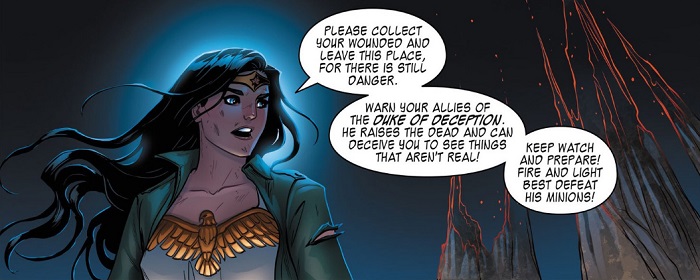
Wonder Woman has gotten the short shrift in popular entertainment. I cannot fathom why a character that has been around for nearly 75 years never made it to the silver screen until some dudebro finally dropped her into another movie about dudebros fighting other dudebros. I don’t want my Diana as second fiddle to a couple of grumpy punching machines. Her fans deserve better. She deserves better. Thankfully we have Renae De Liz and Ray Dillon’s The Legend of Wonder Woman to fall back on.
Legend of Wonder Woman is part bildungsroman, part WWII alt-history, and all enjoyable. Men play a major role in the world, but from Diana’s perspective it’s women who have the greatest impact. The Duke of Deception is an intriguing villain, but it’s Diana’s response to the chaos he sows that makes the story shine. She fights him less because of his general villainy and more because she recognizes that using her abilities to help the helpless is the right thing to do.
The series tackles intersectional feminism on a smaller but no less important scale than Bombshells. It’s all about proving repeatedly that vibrant female relationships and passing the Bechdel test can go hand-in-hand with telling a ripping good yarn. The women navigate femininity in recognizable and moving ways and with a depth not often seen in comic books. It’s a little more serious in tone, but revels in playful moments. On a related side note, Etta is the absolute best thing to happen to DC in ages.
De Liz and Dillon’s art is lovely and charming. The colors are bright and bold, the linework clear and clean, and the characters impressively rendered. Diversity is on full display but in a naturalistic and not-pandering fashion. Etta is a heavyset young woman and her main love interest is a Red Tail pilot. Diana is muscular and tall and for once refuses heavy makeup and heels. Race is a social issue in this world, but no time is wasted on letting racists get on their soapboxes. We are never made to pity Etta for her weight or shame Diana for choosing practicality over fashion. Respect is earned rather than being contingent upon appearance or class. I’d like to see more attention paid to diversity in orientation, identity, and disabilities, but what we’ve gotten so far is still generally more than most of DC’s non-digital offerings.
I’ve never been much for cherishing canon as an immutable force. More often than not I even veer toward preferring fanon over canon, especially when it comes to the lack of stories starring non-cishet white male characters. So Bombshells is pretty much the perfect retcon IMO. In the Bombshells ‘verse, women are the superheroes and villains and men the love interests and henchmen. There’s a dollop of actual history in here but it’s tweaked with SFF in that fabulous way only superhero comics attempt.
But the best part of the series is its rampant intersectional feminism. Legend of Wonder Woman has it too, but Bombshells does more of it with more success by virtue of a much larger cast. There are women of different sizes and body shapes, color, gender identity, and sexual orientation. All are powerful and not just because of their superpowers. Even the main Big Bad is a woman who defies the “bad bitch” stereotype. Bombshells isn’t deep intersectional feminism, but it is necessary and welcome and unfortunately a rarity in the DC realm. There are so many ways a series like this could’ve gone horribly awry, but Marguerite Bennett and co. keep it firmly on point. My only major complaint is that for a digital series the guided view option is clunky to the point of frustrating. Typically I read digital comics on my phablet, but Bombshells was so janky on guided view I gave up and switched to my laptop.
That being said, definitely don’t wait for the print edition unless you really hate digital. This is a series that begs to be read right now. Bombshells and Legend of Wonder Woman are the only DC titles on my subscription list and the only ones I buy new and hot off the (internet) presses. Bombshells is a damn fine series with well-crafted stories and great art—heck, it even made it to my Best Comics of 2015 list. The myriad artists keep the artwork creative and interesting, and each add their own flair to the dieselpunk/art deco/pinup style. The women are sexy but more than sexpots, hot but not to be oogled. Some of the tales are weaker than others and the rapidfire pacing can sometimes hobble the emotional impact, but overall it’s a strong, fun series built around fresh takes on classic characters.
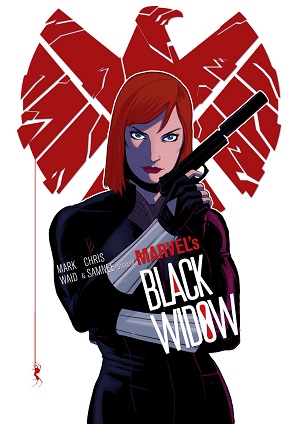 And while you’re off adding comics about awesome BAMF female superheroes to your pull list, set aside another few bucks for Chris Samnee and Mark Waid’s new Black Widow. With the additions of letterer Joe Caramagna and colorist Matthew Wilson, this series is a full reunion of the same group who worked on the recent run of Daredevil. As much as it sucked to see the end of the 2014 run by Nathan Edmonson and Phil Noto, Samnee and Waid are more than up to the task. Only the first issue is out so far—#2 drops April 6, 2016—but it doesn’t waste time setting up the premise. The story opens at full speed with Natasha Romanov in the middle of a bloody, explosive escape from a S.H.I.E.L.D. airship after stealing top secret information.
And while you’re off adding comics about awesome BAMF female superheroes to your pull list, set aside another few bucks for Chris Samnee and Mark Waid’s new Black Widow. With the additions of letterer Joe Caramagna and colorist Matthew Wilson, this series is a full reunion of the same group who worked on the recent run of Daredevil. As much as it sucked to see the end of the 2014 run by Nathan Edmonson and Phil Noto, Samnee and Waid are more than up to the task. Only the first issue is out so far—#2 drops April 6, 2016—but it doesn’t waste time setting up the premise. The story opens at full speed with Natasha Romanov in the middle of a bloody, explosive escape from a S.H.I.E.L.D. airship after stealing top secret information.
There is very little dialogue here, not that it’s needed. Samnee’s detailed art reveals everything we need to know about plot, characters, setting, and tone. Small panels with tight focus smatter the page like gunfire and give way to expansive, immersive spreads that’ll make you gasp. I always love when letterers get creative with depicting sound effects, and Caramagna is quickly becoming one of my favorites. I’ve been a fan of colorist Matthew Wilson since Gillen and McKelvie’s Young Avengers and The Wicked + The Divine, and he brings that same talent to Black Widow.
Of course, I’m a little put out that Black Widow is still in the hands of a bunch of middle-aged white dudes—I mean really, Marvel, you couldn’t get a single woman and/or person of color on the creative side?—but at least I don’t have to worry about them doing anymore character damage than Joss Whedon. Waid and Samnee’s Black Widow got off to an extraordinary start. Count me in as thrilled to see where her story goes from here.
Alex Brown is an archivist, research librarian, writer, geeknerdloserweirdo, and all-around pop culture obsessive who watches entirely too much TV. Keep up with her every move on Twitter and Instagram, or get lost in the rabbit warren of ships and fandoms on her Tumblr.










